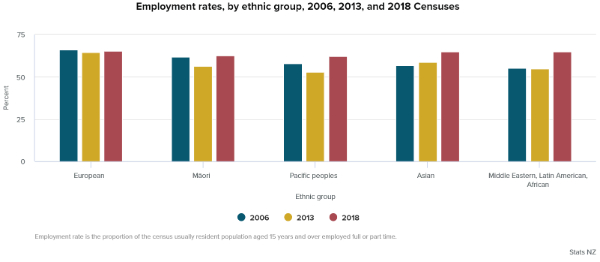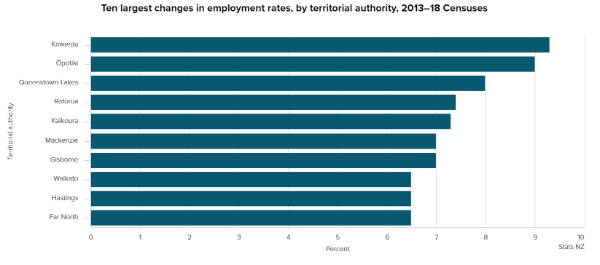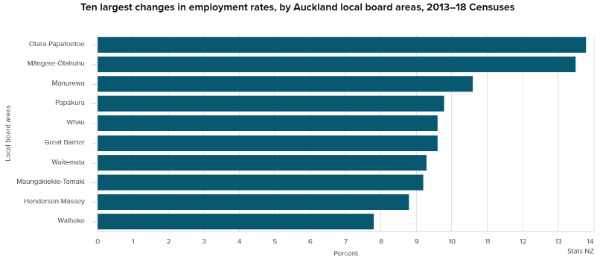Positive Trends For Māori And Pacific Peoples’ Employment After The Global Financial Crisis (GFC)
Census data shows employment recovery post 2008 global financial crisis
Newly released data from the 2018 Census shows positive trends for Māori and Pacific peoples’ employment after the global financial crisis (GFC), Stats NZ said today.
The data, which comprises tables covering work, income, and unpaid activities, also shows interesting changes for women in the workforce.
The data reflects New Zealand’s changing employed population and changing labour market. It has been drawn from the three most recent censuses (2006, 2013, 2018) and shows the variety of work situations, income sources, and unpaid activities of people across New Zealand.
Māori and Pacific employment recovering from GFC impact
In 2018, employment rates for Māori and Pacific people showed significant recovery from the post-GFC rates of the 2013 Census, with 62.5 percent of Māori and 62.3 percent of Pacific peoples employed (up 5.9 percent and 9.6 percent respectively from 2013).
The employment rate is the proportion of the census usually resident population aged 15 years and over who are employed.
As at the 2018 Census, 329,166 Māori were employed out of a total population of 527,058 Māori aged 15 years and over. At the same time, 157,920 Pacific people were in employment, out of a total population of 253,488 Pacific people (aged 15 years and over).
Between 2013 and 2018, the total number of people in employment nationally rose by 22.2 percent to 2.45 million. The number of people aged 15 years and over also increased over this period, up 11.8 percent to 3.78 million. This resulted in a national employment rate of 64.7 percent (up 5.5 percent from 2013).

“Employment rates account for changes in the size of a population, as well as changes in levels of employment,” senior manager census data delivery Susan Hollows said. “They can be used as an indicator of the health of the labour market and as a broader indicator of the state of the economy.”
Our census usually resident population aged 15 years and over has changed since 2013. Growth has been greatest in non-European ethnic groups, with the largest increase recorded for the Middle Eastern, Latin American, and African (MELAA) ethnic group at 51.6 percent. Asian, Pacific peoples, and Māori followed, up 50.6, 33.1, and 33.0 percent respectively. The European ethnic group had the smallest change with a 12.2 percent increase.
“The impact of the late-2000s GFC on New Zealand’s employment rates can be seen clearly in the 2013 Census – especially for Māori and Pacific peoples. However, employment rates have now recovered to pre-GFC levels for all ethnic groups. And the data shows the non-European ethnicities experiencing higher rates of growth in the proportions of their populations in work than the European ethnicities,” Mrs Hollows said.
These changes are due to increases in the number of employed people in each ethnicity. In 2018, the MELAA ethnic group recorded the highest growth in employment rate, with an increase of 9.9 percent (15,147 people). The second largest increase was for Pacific peoples at 9.6 percent (57,549 people).
The 15-to 24-year-old age group experienced the greatest change in employment rate between the 2013 and 2018 Censuses, with increases across all ethnicities. The largest increases were for Pacific peoples (15.0 percent), MELAA (13.4 percent), Māori (12.4 percent), and Asian (10.1 percent). The European ethnic group experienced the smallest increase at 6.1 percent.

At the 2018 Census, 8.2 percent of Europeans aged 65 years and over were in employment. This is more than twice the proportion of the next largest ethnicity for this age group (Māori, at 4.0 percent).
Employment rate stronger in the regions
The employment rates for our three main cities, Auckland, Wellington, and Christchurch (65.5, 71.3, and 65.3 percent respectively) were higher than the national average of 64.7 percent.
Auckland saw the largest increase in people employed since the 2013 Census. However, it did not record the largest change in employment rate as a proportion of its population aged 15 years and over. That was recorded in Kawerau district, which experienced a 9.3 percent increase in employment (an increase of 774 people). Ōpōtiki district had the second largest increase at 9.0 percent (978 people).

The Auckland local boards that experienced the largest increase in employment rates were Ōtara-Papatoetoe (13.8 percent or 12,975 people) and Māngere-Ōtahuhu (13.5 percent or 10,941 people).

Significant employment changes for women
Between 2013 and 2018, the number of women in employment increased 21.4 percent to 1.16 million (the first time ever there has been over a million women in employment in New Zealand). At the same time, the number of men in employment increased 22.9 percent to 1.29 million. This resulted in employment rates of 60.0 percent for women and 69.7 percent for men. The female employment rate grew at a greater rate than the male employment rate (5.6 percent compared with 5.2 percent respectively).
During the same period, the number of women in part-time employment was more than twice that of men (68.7 percent compared with 31.3 percent respectively).
“It’s not just the age and sex profile of the working population that changes over time,” Mrs Hollows said. “The ways and places people work are also changing, and this is especially true for women, who are moving into less traditional fields at increasing rates.”
Looking at the female workforce, between 2013 and 2018, the proportion of women working in the professional, scientific, and technical services sector increased the most (1.4 percent) to account for around 9.9 percent of all women in employment. The proportion of women working in the retail trade sector decreased the most, down 1.1 percent. Women working in retail and trade represented around 10.4 percent of employed women in 2018.
In 2018, the largest proportion of employed women (16.2 percent or 187,707 women) worked in the health care and social assistance industry, which includes hospitals and residential care services.
About the 2018 Census dataset
We combined data from the census forms with administrative data to create the 2018 Census dataset, which meets Stats NZ’s quality criteria for population structure information.
We added real data about real people to the dataset where we were confident the people should be counted but hadn’t completed a census form. We also used data from the 2013 Census and administrative sources and statistical imputation methods to fill in some missing characteristics of people and dwellings.
Data quality for 2018 Census provides more information on the quality of the 2018 Census data. An independent panel of experts has assessed the quality of the 2018 Census dataset. The panel has endorsed Stats NZ’s overall methods and concluded that the use of government administrative records has improved the coverage of key variables such as age, sex, ethnicity, and place. The panel’s Initial Report of the 2018 Census External Data Quality Panel assessed the methodologies used by Stats NZ to produce the final dataset, as well as the quality of some of the key variables. Its second report 2018 Census External Data Quality Panel: Assessment of variables assessed an additional 31 variables.
In its third report, Final report of the 2018 Census External Data Quality Panel, the panel made 24 recommendations, several relating to preparations for the 2023 Census. Along with this report, the panel, supported by Stats NZ, produced a series of graphs summarising the sources of data for key 2018 Census individual variables, 2018 Census External Data Quality Panel: Data sources for key 2018 Census individual variables.
Quick guide to the 2018 Census (updated 16 September 2019) outlines the key changes we introduced as we prepared for the 2018 Census and the changes we made once collection was complete.
The geographic boundaries are as at 1 January 2018. See Statistical standard for geographic areas 2018.
Definitions and metadata
2018 Census – DataInfo+ provides information about methods and related metadata.
2018 Census information by variable and quality – DataInfo+ provides information about the variables and their quality.
Data quality ratings for 2018 Census variables provides information on data quality ratings.


 Gordon Campbell: On What’s Wrong With The Treaty Principles Bill
Gordon Campbell: On What’s Wrong With The Treaty Principles Bill Department Of Internal Affairs: Samoan Citizenship Bill Passes Into Law
Department Of Internal Affairs: Samoan Citizenship Bill Passes Into Law NZ National Party: National Acknowledges The Passing Of Hon Nikki Kaye
NZ National Party: National Acknowledges The Passing Of Hon Nikki Kaye Mana Mokopuna: Children And Young People Share Vital Insights On Healing From Family Violence And Sexual Violence In New Report
Mana Mokopuna: Children And Young People Share Vital Insights On Healing From Family Violence And Sexual Violence In New Report NZ Government: PM Marks One Year In Government
NZ Government: PM Marks One Year In Government Helen Clark Foundation: Helen Clark Foundation Calls For Political Action To Reduce The Prevalence Of Junk Food And Improve Health Outcomes
Helen Clark Foundation: Helen Clark Foundation Calls For Political Action To Reduce The Prevalence Of Junk Food And Improve Health Outcomes Justice Committee: Further Decisions About Submissions Process For The Principles Of The Treaty Of Waitangi Bill
Justice Committee: Further Decisions About Submissions Process For The Principles Of The Treaty Of Waitangi Bill


